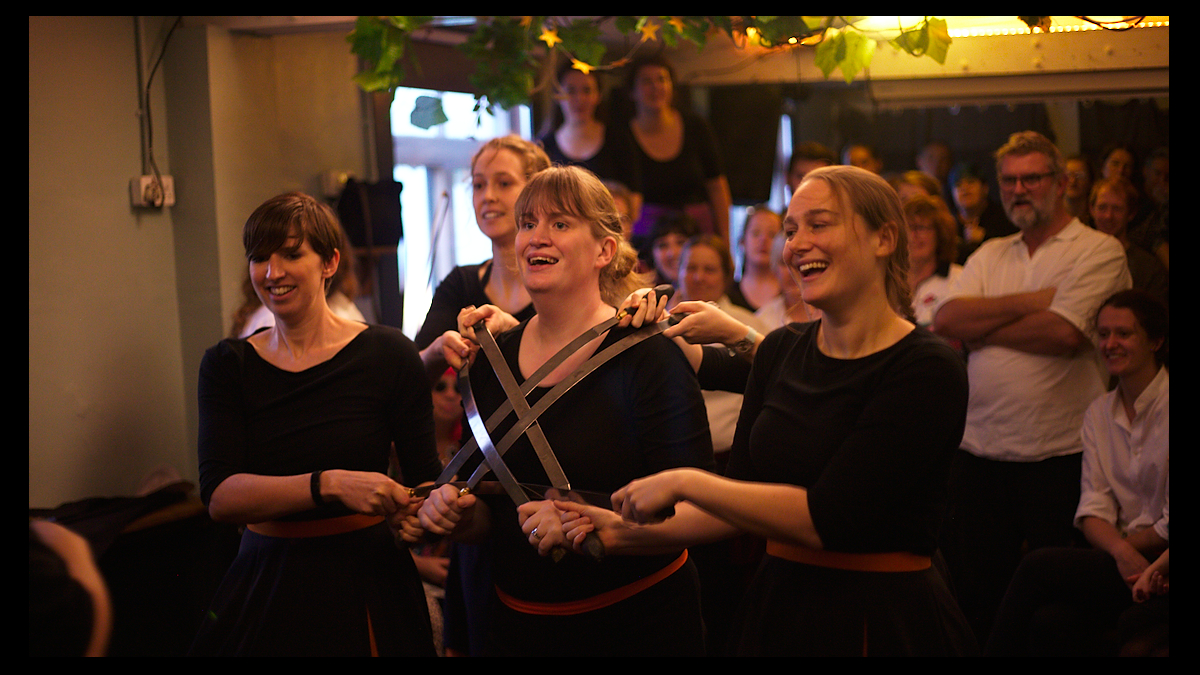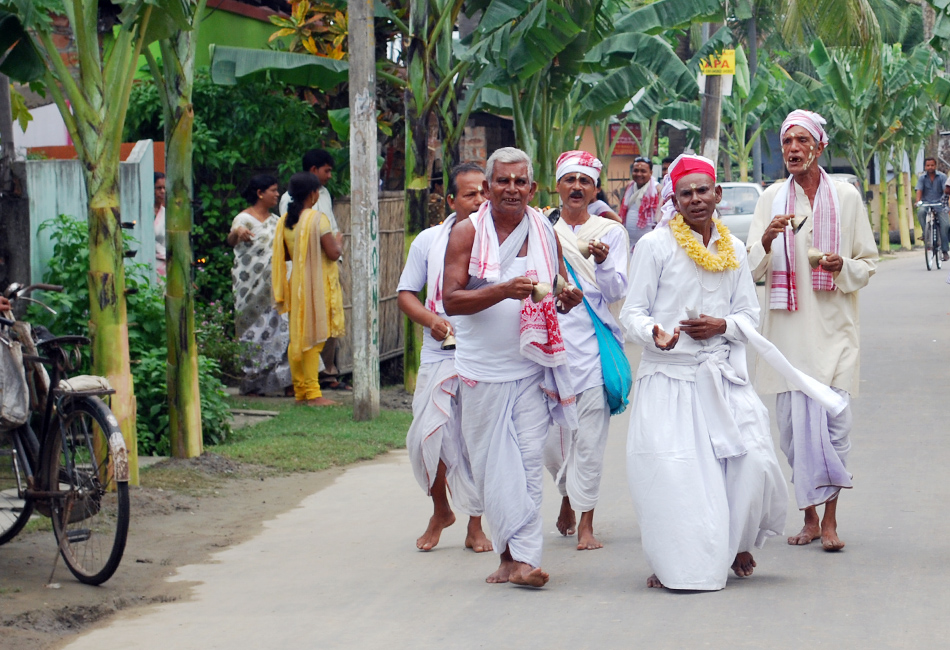|
Deodhani Dance
Deodhani dance is a Shaman folk dance from the Indian state of Assam. It can be performed either solo or in a group. Deodhani is of Bodo origin. A group performance of Deodhani generally consists of three or four women. The dance form is associated with the worship of the snake goddess Marei/Maroi. A Deodhani dance is generally performed to the accompaniment of songs sung by an '' Ojha'', a traditional chorus leader in the Darrang district of Assam.Oja-pali , WebIndia History  Deodhani is derived from two words – ''Deo'', which means God, and ''Dhani'', which means woman, literally meaning a woman possessed ...
Deodhani is derived from two words – ''Deo'', which means God, and ''Dhani'', which means woman, literally meaning a woman possessed ...
[...More Info...] [...Related Items...] OR: [Wikipedia] [Google] [Baidu] |
Shaman
Shamanism is a spiritual practice that involves a practitioner (shaman) interacting with the spirit world through altered states of consciousness, such as trance. The goal of this is usually to direct spirits or spiritual energies into the physical world for the purpose of healing, divination, or to aid human beings in some other way. Beliefs and practices categorized as shamanic have attracted the interest of scholars from a variety of disciplines, including anthropologists, archeologists, historians, religious studies scholars, philosophers, and psychologists. Hundreds of books and academic papers on the subject have been produced, with a peer-reviewed academic journal being devoted to the study of shamanism. Terminology Etymology The Modern English word ''shamanism'' derives from the Russian word , , which itself comes from the word from a Tungusic language – possibly from the southwestern dialect of the Evenki spoken by the Sym Evenki peoples, or from the ... [...More Info...] [...Related Items...] OR: [Wikipedia] [Google] [Baidu] |
Folk Dance
A folk dance is a dance that reflects the life of the people of a certain country or region. Not all ethnic dances are folk dances. For example, Ritual, ritual dances or dances of ritual origin are not considered to be folk dances. Ritual dances are usually called "religious dances" because of their purpose. The terms "ethnic" and "traditional" are used when it is required to emphasize the cultural roots of the dance. In this sense, nearly all folk dances are ethnic ones. If some dances, such as polka, cross ethnic boundaries and even cross the boundary between "folk" and "ballroom dance", ethnic differences are often considerable enough to mention. Background Folk dances share some or all of the following attributes: *Dances are usually held at folk dance gatherings or social functions by people with little or no professional training, often to traditional music. *Dances not generally designed for public performance or the stage, though they may later be arranged and set for ... [...More Info...] [...Related Items...] OR: [Wikipedia] [Google] [Baidu] |
India
India, officially the Republic of India, is a country in South Asia. It is the List of countries and dependencies by area, seventh-largest country by area; the List of countries by population (United Nations), most populous country since 2023; and, since its independence in 1947, the world's most populous democracy. Bounded by the Indian Ocean on the south, the Arabian Sea on the southwest, and the Bay of Bengal on the southeast, it shares land borders with Pakistan to the west; China, Nepal, and Bhutan to the north; and Bangladesh and Myanmar to the east. In the Indian Ocean, India is near Sri Lanka and the Maldives; its Andaman and Nicobar Islands share a maritime border with Thailand, Myanmar, and Indonesia. Modern humans arrived on the Indian subcontinent from Africa no later than 55,000 years ago., "Y-Chromosome and Mt-DNA data support the colonization of South Asia by modern humans originating in Africa. ... Coalescence dates for most non-European populations averag ... [...More Info...] [...Related Items...] OR: [Wikipedia] [Google] [Baidu] |
Assam
Assam (, , ) is a state in Northeast India, northeastern India, south of the eastern Himalayas along the Brahmaputra Valley, Brahmaputra and Barak River valleys. Assam covers an area of . It is the second largest state in Northeast India, northeastern India by area and the largest in terms of population, with more than 31 million inhabitants. The state is bordered by Bhutan and Arunachal Pradesh to the north; Nagaland and Manipur to the east; Meghalaya, Tripura, Mizoram and Bangladesh to the south; and West Bengal to the west via the Siliguri Corridor, a strip of land that connects the state to the rest of India. Assamese language, Assamese and Bodo language, Bodo are two of the official languages for the entire state and Meitei language, Meitei (Manipuri language, Manipuri) is recognised as an additional official language in three districts of Barak Valley and Hojai district. in Hojai district and for the Barak valley region, alongside Bengali language, Bengali, which is also ... [...More Info...] [...Related Items...] OR: [Wikipedia] [Google] [Baidu] |
Solo Dance
A solo dance is a dance done by an individual dancing alone, as opposed to couples dancing together but independently of others dancing at the same time, if any, and as opposed to groups of people dancing simultaneously in a coordinated manner. Solo dancers are usually the best dancers in a group or dance school. Most solo dancers start after about 6–7 years of dance or sooner. Most soloists are company kids from their dance school. They are usually in more than one dance. In Comparsas, there are various soloists who strut in front. They usually dance at the edges of the street so that the viewing public can appreciate their moves. Most male soloists carry a large lantern-like artifact on a large pole, resting on an oily pouch, which they spin at will. Dance is a way to express emotions. See also *Sean-nós dance * Sean-nós dance in America *Irish dance Irish dance refers to the traditional dance forms that originate in Ireland, including both solo and group dance form ... [...More Info...] [...Related Items...] OR: [Wikipedia] [Google] [Baidu] |
Boro People
The Boro (बर'/बड़ो ), also called Bodo, are a Tibeto-Burman speaking ethnolinguistic group native to the state of Assam in India. They are a part of the greater Bodo-Kachari family of ethnolinguistic groups and are spread across northeastern India. They are concentrated mainly in the Bodoland Territorial Region of Assam, though Boros inhabit all other districts of Assam and Meghalaya. Boros were listed under both "Boro" and "Borokachari" in The Constitution (Scheduled Tribes) Order, 1950, and are continued to be called so in the Census of India documents. Boros speak the Boro language, a Boro-Garo language of the Tibeto-Burman family, which is recognised as one of twenty-two Scheduled languages of India. Over two-thirds of the people are bilingual, speaking Assamese as second language. The Boro along with other cognate groups of Bodo-Kachari peoples are prehistoric settlers who are believed to have migrated at least 3,000 years ago. Boros are mostly settled ... [...More Info...] [...Related Items...] OR: [Wikipedia] [Google] [Baidu] |
Bodo People
The Boro (बर'/बड़ो ), also called Bodo, are a Tibeto-Burman languages, Tibeto-Burman speaking ethnolinguistic group native to the state of Assam in India. They are a part of the greater Bodo-Kachari people, Bodo-Kachari family of ethnolinguistic groups and are spread across northeastern India. They are concentrated mainly in the Bodoland Territorial Region of Assam, though Boros inhabit all other districts of Assam and Meghalaya. Boros were listed under both "Boro" and "Borokachari" in The Constitution (Scheduled Tribes) Order, 1950, and are continued to be called so in the Census of India documents. Boros speak the Boro language (India), Boro language, a Boro-Garo languages, Boro-Garo language of the Tibeto-Burman family, which is recognised as one of twenty-two Scheduled languages of India. Over two-thirds of the people are bilingual, speaking Assamese as second language. The Boro along with other cognate groups of Bodo-Kachari peoples are prehistoric settlers who ... [...More Info...] [...Related Items...] OR: [Wikipedia] [Google] [Baidu] |
Darrang District
Darrang () is an administrative district in the state of Assam in India. The district headquarters are located at Mangaldoi. The district occupies an area of 1585 km2. Etymology The etymology of Darrang reflects its historical significance as a gateway. According to scholar Late Dineshwar Sarma, the name comes from the Assamese word " Doar," meaning "door," which refers to the alluvial floodplains in eastern and northeastern India that have long served as passageways for traders and travelers from the Himalaya and also as critical entry point for merchants from regions such as China, Tibet, Bhutan, and Central Asia. History No definitive records about Darrang are available for the pre-medieval period. According to Maheswar Neog, the Darrang became mentioned only after the uprising of the king Nara Narayan. Darrang at different times might have been under the rule of the Chutia Kingdom, Bodo people and Baro-Bhuyans. During the reign of Dharmanarayan 3000 Chutia famil ... [...More Info...] [...Related Items...] OR: [Wikipedia] [Google] [Baidu] |
Ojapali
Ojapali is a traditional shamanistic type of indigenous folk dance from Assam in the northeastern region of India. Ojapali is believed to have evolved from Kathakata tradition and is performed in a group; it is believed to be one of the oldest art forms of Assam. Originally evolved in the Kamata state the western and northern part of river Brahmaputra later limited to Darrang area under the patronisation of Darrangi King Dharmanarayana. The repertoire of this performance consists of songs, dialogues, gesture, improvised acting and dramatisation etc. The group consists of an Oja, who leads the performance and four or five palies, who supplement the performance with continuously playing cymbal. Among the Palies, Daina pali who stands on the right-hand side of the Oja is the active one and he and Oja take the performance forward. Many believe that Shankardev took inspiration from Ojapali to create his Ankiya Bhaona. Moreover, he also created his own Sattriya Ojapali. Generally D ... [...More Info...] [...Related Items...] OR: [Wikipedia] [Google] [Baidu] |
War Dance
A war dance is a dance involving mock combat, usually in reference to tribal warrior societies where such dances were performed as a ritual connected with endemic warfare. Martial arts in various cultures can be performed in dance-like settings for various reasons, such as for evoking ferocity in preparation for battle or showing off skill in a more stylized manner. It could also be for celebration of valor and conquest. Many such martial arts incorporate music, especially strong percussive rhythms. War dances can overlap with sword dances and other forms of weapon dance, utilizing weapons or replications as part of the artistic performance. File:Neferhotep Tahtib.JPG, Egyptian Tahtib File:Papuan Dance from Yapen.jpg, Papuan war dance from Yapen, Papua File:Capoeira-three-berimbau-one-pandeiro.jpg, Capoeira is a martial art traditionally performed with a dance-like flavor and to live musical accompaniment, as seen depicted here. War dances Examples of war dances include ... [...More Info...] [...Related Items...] OR: [Wikipedia] [Google] [Baidu] |
Dances Of Assam
Dance is an art form, consisting of sequences of body movements with aesthetic and often symbolic value, either improvised or purposefully selected. Dance can be categorized and described by its choreography, by its repertoire of movements or by its historical period or place of origin. Dance is typically performed with musical accompaniment, and sometimes with the dancer simultaneously using a musical instrument themselves. Two common types of group dance are theatrical and participatory dance. Both types of dance may have special functions, whether social, ceremonial, competitive, erotic, martial, sacred or liturgical. Dance is not solely restricted to performance, as dance is used as a form of exercise and occasionally training for other sports and activities. Dance performances and dancing competitions are found across the world exhibiting various different styles and standards. Dance may also be participated in alone as a form of exercise or self expression. Dancing is ... [...More Info...] [...Related Items...] OR: [Wikipedia] [Google] [Baidu] |






